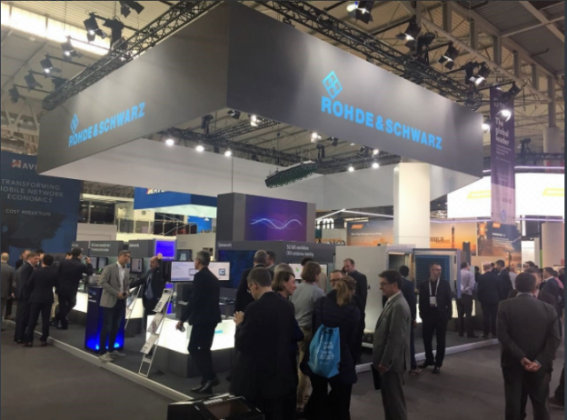
Germany-based test and measurement company Rohde & Schwarz has made several announcements at the Mobile World Congress 2018.
ZTE
Rohde & Schwarz has supplied its CMW500 mobile communication tester to verify functions of ZTE’s 1.2 Gbps smartphone that was displayed at the MWC 2018. The DL Cat-18 smartphone can support download speed up to 1.2 Gbps by using 3CC downlink carrier aggregation with 4×4 MIMO and 256QAM modulation.
Engineers at ZTE, a leading smartphone company, used the R&S CMW500 test platform for simulating and verifying the combination of signaling and end-to-end data transmission on the involved carriers.
ZTE engineers used the R&S CMW500 in its R&S CMW flexx configuration, which is the first test platform that offers enhanced carrier aggregation (eCA) capabilities for up to 8CC including 4×4 MIMO, for protocol, RF and data performance verifications.
Telit
R&S has also conducted live testing of Telit NBIoT modules at the R&S MNT booth 6C51 at MWC 2018 to measure coverage and RF performance and to get insights such as channel allocation and power efficiency.
Ficosa
Ficosa, a supplier of automotive parts and systems, has used the Rohde & Schwarz eCall test solution for verification of emergency call functionality.
Rohde & Schwarz has extended its eCall test solution, which utilizes R&S CMW500 platform, to cover LTE-based emergency call system (NGeCall). The two companies conducted functional tests of a telematic control unit (TCU) with a next generation eCall modem that uses the LTE network.
Ficosa provided a TCU with a eCall modem to verify this functionality. The TCU can send the vehicle’s position taken from an integrated GPS receiver and is able to make an emergency call during an accident via LTE.
Laura Tantinyà, RF engineering supervisor at Barcelona-based Ficosa, said: “Rohde & Schwarz was always the first choice when Ficosa was looking for a way to validate its automotive products.”
CommSolid
Rohde & Schwarz has completed the verification of 3GPP Release 14 location services (LCS), a new positioning technology for NarrowBand-IoT (NB-IoT) from CommSolid. Engineers at Rohde & Schwarz conducted the Cat-NB2 verification of CommSolid’s NB-IoT modem solution using the R&S CMW500 mobile communication tester.
The R&S Location Based Services (LBS) solution based on R&S CMWcards GUI, a subset of TS-LBS, allows the verification of chipsets and mobile devices for mobile manufacturers, chipset manufacturers, test houses and network operators with the target to get permission to operate them in a particular network.
The R&S CMW500 mobile communication tester equipped with the R&S CMWcards LBS solution and the CommSolid NB-IoT modem form the first test platform to offer verification of Cat-NB2 location services.
Matthias Weiss, managing director at CommSolid, said: “Rohde & Schwarz enables us to develop and verify our Cat-NB2 modem early on. Our reference device provides a full software upgradable Cat-NB2 advanced implementation and achieves positioning accuracy.”
Huawei
Huawei has selected Rohde & Schwarz for its testing solutions for NB-IoT terminal chipsets designed by HiSilicon. Huawei will use R&S test solutions from R&D to certification and final device production. Rohde & Schwarz is one of only a few suppliers of 3GPP NB-IoT T&M equipment officially listed by the Global Certification Forum (GCF).
Rohde & Schwarz test equipment for NB-IoT testing includes the R&S CMW500 wideband radio communication tester. R&S CMW500 test platform offers a single-instrument solution for protocol and RF/RRM conformance tests.
Huawei chipset and device engineers can transfer data and test setups for protocol tests, RF/RRM testing, callbox functionality and RF tests for production. The R&S CMW290, a dedicated IoT callbox, adds NB-IoT RF testing capability, allowing functional, mobility and IP throughput tests.
Huawei used Rohde & Schwarz testing solutions to demo 1.6 Gbps LTE-A-Pro downlink throughput, using Huawei Balong 765, the industry’s first LTE modem to support category 19 at 1.6 Gbps technology.
Ai Wei, fellow at Huawei, said: “With technologies of 8×8 MIMO, 5CC CA, 256QAM, the Balong 765 will help operators boost network capacity and will take consumers to higher-speed and highly immersive experience. Moreover, Balong 765 can help operators to provide reliable connectivity and roll out Internet of Things solutions.”
Rohde & Schwarz showcased its CMW500 wideband radio communication tester and a pre-commercial Qualcomm 9150 C-V2X chipset solution, that implements 3rd Generation Partnership Project (3GPP) Release 14 cellular vehicle-to-everything (C-V2X) direct communications technology.
The R&S CMW-KU514 C-V2X verification scenarios option on the R&S CMW500 is used to demonstrate simulation of an ITS message transfer from one vehicle to another during emergency braking.
Manufacturers of Bluetooth LE components can use R&S CMW270 wireless connectivity tester from Rohde & Schwarz to conduct over-the-air (OTA) tests on Bluetooth LE devices, same as for Bluetooth Classic devices.
Rohde & Schwarz presented the world’s first test solution for a chipset that utilizes enhanced Carrier Aggregation (eCA) for LTE mobile broadband transmissions. The chipset receives and processes eight downlink carrier signals in parallel, allowing transmission rates of up to 2 Gbit/s in current LTE networks.
Rohde & Schwarz also presented 5G NR sub 6 GHz and 5G NR mmW test solutions at MWC 2018. Engineers can use R&S FSW signal and spectrum analyzer and R&S SMW200A vector signal generator for generating and analyzing 5G NR signals to test base stations, UE and 5G components such as power amplifier.
The R&S SMW-K144 5G NR signal generation option will enable users to generate signals for 5G NR downlink and uplink in line with 3GPP Release 15, specifically the 3GPP TS 38.211, 38.212, 38.213 and 38.214 specifications for the NR physical layer and transport layer.
The R&S FSW-K144 5G NR signal analysis option verifies the implementation of the 5G NR downlink signals. Developers will be able to test compliance with the 3GPP standard, enabling them to validate for instance 5G base stations in ways that cannot be achieved with general-purpose solutions on the market.
Baburajan K





